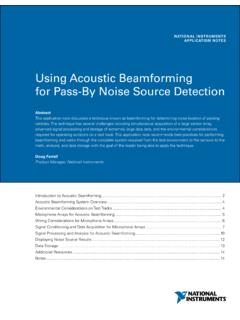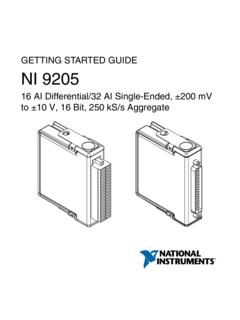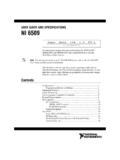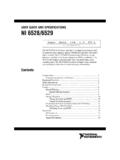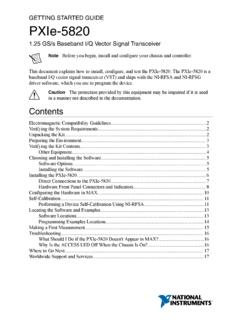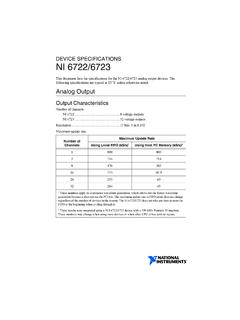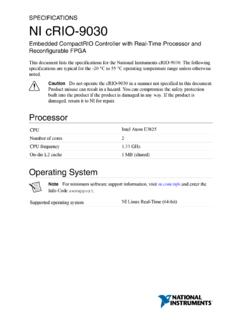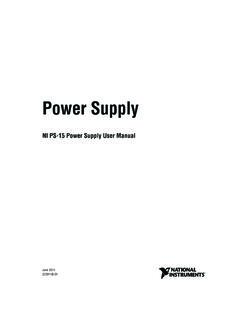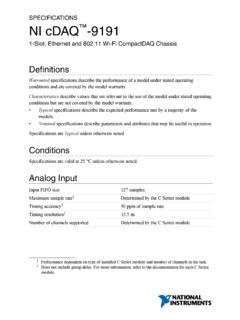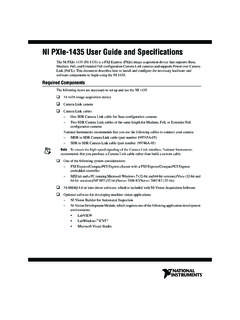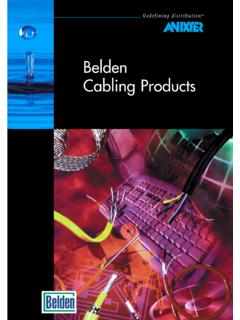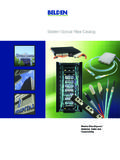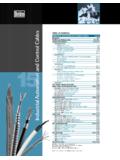Transcription of 1-Port, LIN Module - National Instruments
1 OPERATING INSTRUCTIONS. NI 9866. 1-Port, LIN Module These operating instructions describe how to use the National Instruments (NI) 9866 Module . For information about installing, configuring, and programming your system, refer to your system documentation. The NI 9866 Module requires the latest NI-XNET. software to be installed. The latest version of the NI-XNET. software is at Note The safety guidelines and specifications in this document are specific to the NI 9866. The other components in your system may not meet the same safety ratings and specifications. Refer to the documentation for each component in your system to determine the safety ratings and specifications for the entire system. NI 9866 Operating Instructions 2 Safety Guidelines Caution Do not operate the NI 9866 in a manner not specified in the user manual or operating instructions. Product misuse can result in a hazard. You can compromise the safety protection built into the product if the product is damaged in any way.
2 If the product is damaged, return it to National Instruments for repair. Hot Surface This icon denotes that the component may be hot. Touching this component may result in bodily injury. Safety Guidelines for Hazardous Locations The NI 9866 is suitable for use in Class I, Division 2, Groups A, B, C, D, T4 hazardous locations; Class I, Zone 2, AEx nA IIC T4 and Ex nA IIC T4 hazardous locations; and nonhazardous locations only. Follow these guidelines if you are installing the NI 9866 in a potentially explosive environment. Not following these guidelines may result in serious injury or death. Caution Do not disconnect I/O-side wires or connectors unless power has been switched off or the area is known to be nonhazardous. National Instruments 3 NI 9866 Operating Instructions Caution Do not remove modules unless power has been switched off or the area is known to be nonhazardous. Caution Substitution of components may impair suitability for Class I, Division 2.
3 Caution For Zone 2 applications, install the CompactRIO system in an enclosure rated to at least IP 54 as defined by IEC 60529 and EN 60529. Caution For Zone 2 applications, install a protection device between the LIN signals and the NI 9866 LIN. pins. The device must prevent the LIN Port-to-COM. voltage from exceeding 55 V if there is a transient overvoltage condition. Special Conditions for Safe Use in Europe This equipment has been evaluated as Ex nA IIC T4 equipment under DEMKO Certificate No. 07 ATEX 0626664X. Each Module is marked II 3G and is suitable for use in Zone 2 hazardous locations. NI 9866 Operating Instructions 4 Wiring the NI 9866. The NI 9866 has one 9-pin male D-Sub connector that provides connections to a LIN bus. The port has two common pins (COM) that are internally connected to the Module 's isolated reference and serve as the reference ground for LIN signal. You can connect the LIN bus reference ground to one or both COM pins.
4 The port also has an optional shield pin, SHLD, that you can connect to a shielded LIN. cable. Connecting SHLD may improve signal integrity and EMC. performance in a noisy environment. Caution You must use a UL listed ITE power supply marked LPS with the NI 9866. The NI 9866 requires an external power supply of +8 to +18 V to operate. Supply power to the NI 9866 VSUP pin from the LIN bus. Note Power on VSUP is required for LIN operation. National Instruments 5 NI 9866 Operating Instructions The NI 9866 pinout is listed in Table 1. Table 1. Pin Assignments for the NI 9866. Connector Pin Signal 1 No Connection (NC). 2 NC. 3 COM. 1. 4 NC. 6. 2. 7. 3 5 SHLD. 8. 4. 9. 5. 6 COM. 7 LIN. 8 NC. 9 VSUP. NI 9866 Operating Instructions 6 Cabling Requirements for NI 9866. This section deals with cabling specifications, termination resistors, cable lengths, and the number of LIN nodes that can exist in a system.
5 Cable Specifications LIN cables should meet the physical medium requirement of a bus RC time constant of 5 s. For detailed formulas for calculating this value, refer to the Line Characteristics section of the LIN. specification. Belden cable (3084A) and other unterminated CAN/Serial quality cables meet these requirements and should be suitable for most applications. Cable Lengths The maximum allowable cable length is 40 m, per the LIN. specification. Number of LIN Devices The maximum number of devices on a LIN bus is 16, per the LIN. specification. National Instruments 7 NI 9866 Operating Instructions Termination Resistors LIN cables require no termination, as nodes are terminated at the transceiver. Slave nodes typically are pulled up from the LIN bus to VBat with a 30 k resistance and a serial diode. This termination usually is integrated into the transceiver package. The master node requires a 1 k resistor and serial diode between the LIN bus and VBat.
6 On NI-XNET LIN products, master termination is software selectable; you can enable it in the API. with the NI-XNET Session Interface:LIN:Termination property. NI 9866 Hardware Overview The NI 9866 has one full-featured LIN port that is isolated from the other modules in the system. The port has a LIN controller that is fully compliant with the LIN Specification. The port also has an NXP TJA1028 LIN transceiver that is fully compatible with the LIN and SAE J2602 standard and supports baud rates up to 20 kbps. NI 9866 Operating Instructions 8 Vsup Ext Pwr +. Supply _. COM Required LIN Rx Rx LIN. Tx Tx LIN. Controller Transceiver Figure 1. NI 9866 Hardware Overview Specifications The following specifications are typical for the range 40 to 70 C. unless otherwise noted. LIN Characteristics NXP TJA1028. Max baud rate .. 20 kbps LIN bus lines voltage .. 40 to +40 VDC. National Instruments 9 NI 9866 Operating Instructions Supply voltage range (VSUP.)
7 +8 to +18 VDC normal operation, to +40 V. absolute limits MTBF .. Contact NI for Bellcore MTBF or MIL-HDBK-217F. specifications Power Requirements Power consumption from chassis .. 1 W max (active mode). Thermal dissipation (at 70 C).. W max (active mode). Physical Characteristics Caution If you need to clean your NI 9866, wipe it with a dry towel. The product must be completely dry and free from contaminants before you return it to service. Approx. 144 g ( oz). NI 9866 Operating Instructions 10 Safety Maximum Voltage1. Connect only voltages that are within these limits. 40 to +40 VDC max, Measurement Category I. Measurement Category I is for measurements performed on circuits not directly connected to the electrical distribution system referred to as MAINS voltage. MAINS is a hazardous live electrical supply system that powers equipment. This category is for measurements of voltages from specially protected secondary circuits.
8 Such voltage measurements include signal levels, special equipment, limited-energy parts of equipment, circuits powered by regulated low-voltage sources, and electronics. CautionDo not connect to signals or use for measurements within Measurement Categories II, III, or IV. 1 The maximum voltage that can be applied or output between any port or VSUP. terminal and a COM terminal without creating a safety hazard. National Instruments 11 NI 9866 Operating Instructions Isolation Voltages Port-to-earth ground 1000 Vrms, verified by a 5 s dielectric withstand test Continuous .. 60 VDC, Measurement Category I. Safety Standards This product meets the requirements of the following standards of safety for electrical equipment for measurement, control, and laboratory use: IEC 61010-1, EN 61010-1. UL 61010-1, CSA 61010-1. Note For UL and other safety certifications, refer to the product label or the Online Product Certification section.
9 Hazardous Locations (UL) .. Class I, Division 2, Groups A, B, C, D, T4;. Class I, Zone 2, AEx nA IIC T4. NI 9866 Operating Instructions 12 Canada (C-UL) .. Class I, Division 2, Groups A, B, C, D, T4;. Class I, Zone 2, Ex nA IIC T4. Europe (DEMKO).. Ex nA IIC T4. Environmental Refer to the installation instructions for the chassis you are using for more information about meeting these specifications. Operating temperature .. 40 to 70 C. Storage temperature .. 40 to 85 C. Ingress IP 40. Operating 10 to 90% RH, noncondensing Storage 5 to 95% RH, noncondensing Pollution Degree (IEC 60664) .. 2. Maximum 2,000 m Indoor use only. National Instruments 13 NI 9866 Operating Instructions Shock and Vibration To meet these specifications, you must panel mount the CompactRIO system. Operating vibration, random (IEC 5 grms, 10 to 500 Hz Operating shock (IEC 60068-2-27).. 30 g, 11 ms half sine, 50 g, 3 ms half sine, 18 shocks at 6 orientations Operating vibration, sinusoidal (IEC 60068-2-6).)
10 5 g, 10 to 500 Hz Electromagnetic Compatibility This product meets the requirements of the following EMC. standards for electrical equipment for measurement, control, and laboratory use: EN 61326 (IEC 61326): Class A emissions; Basic immunity EN 55011 (CISPR 11): Group 1, Class A emissions AS/NZS CISPR 11: Group 1, Class A emissions FCC 47 CFR Part 15B: Class A emissions ICES-001: Class A emissions NI 9866 Operating Instructions 14 Note For the standards applied to assess the EMC of this product, refer to the Online Product Certification section. Note For EMC compliance, operate this product according to the documentation. CE Compliance This product meets the essential requirements of applicable European Directives as follows: 2006/95/EC; Low-Voltage Directive (safety). 2004/108/EC; Electromagnetic Compatibility Directive (EMC). National Instruments 15 NI 9866 Operating Instructions Online Product Certification Refer to the product Declaration of Conformity (DoC) for additional regulatory compliance information.
